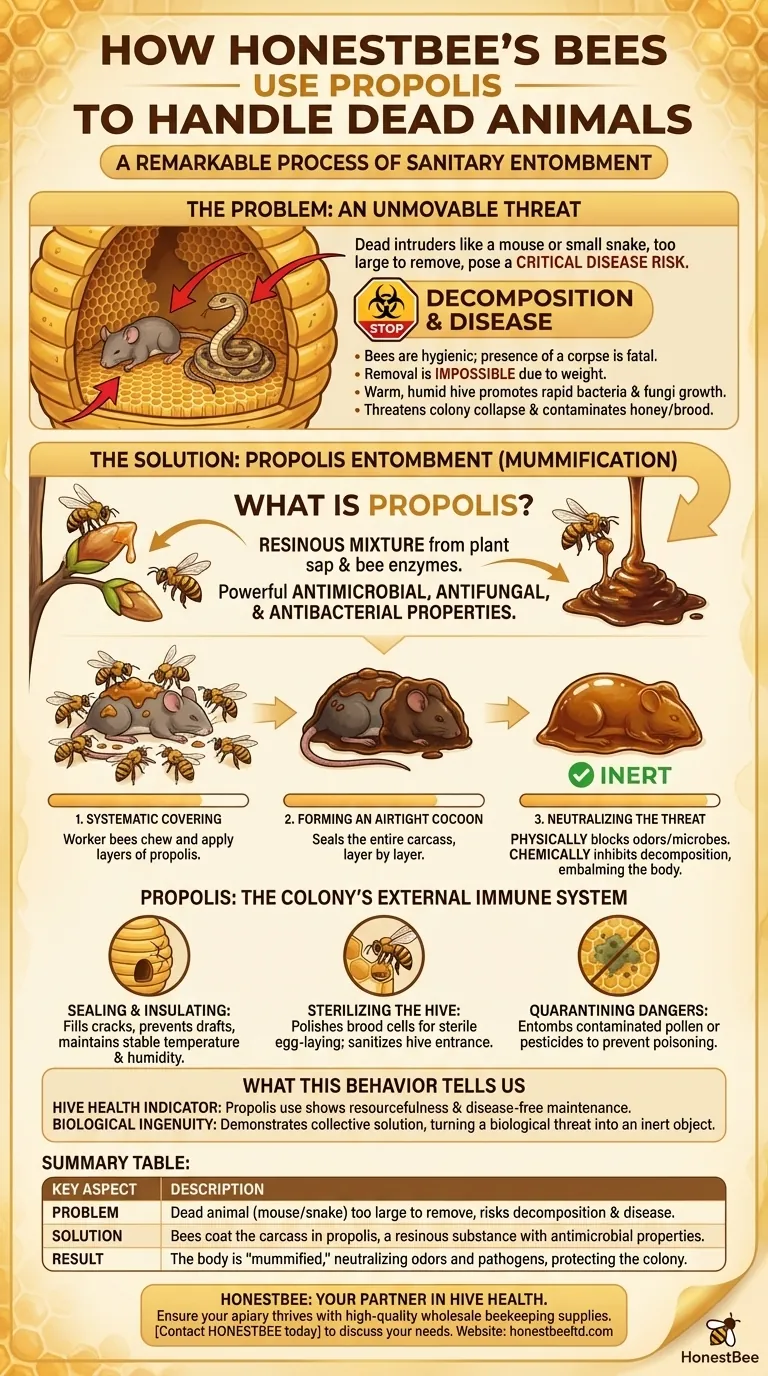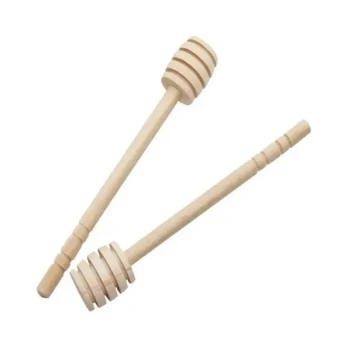When faced with a dead animal too large to remove from the hive, honey bees engage in a remarkable process of sanitary entombment. They meticulously coat the entire carcass in a thick layer of propolis, a resinous substance they produce. This "mummifies" the body, neutralizing it as a source of decomposition and disease and effectively sealing it off from the rest of the colony.
A dead mouse or snake inside a hive presents a critical threat of disease. Since the bees cannot physically remove such a large object, they use their unique biological cement—propolis—to create an antimicrobial tomb, rendering the threat inert.

The Problem: An Unmovable Threat
Honey bees are exceptionally clean insects, and maintaining hive hygiene is critical to their survival. The presence of a dead intruder, like a mouse or small snake that has breached the hive and been stung to death, poses an immediate and severe risk.
When Removal Fails
A single bee can carry objects roughly half its own body weight. While bees will work together to remove smaller debris or dead bees, a carcass weighing many grams is an impossible task for them to drag out of the hive.
The Risk of Decomposition
A decomposing body inside the warm, humid environment of the hive would quickly become a breeding ground for harmful bacteria, fungi, and pathogens. This could lead to widespread disease, contaminate honey and brood, and threaten the collapse of the entire colony.
The Solution: Propolis Entombment
Unable to remove the threat, the bees pivot to a strategy of containment and neutralization using their most versatile tool.
What is Propolis?
Propolis is a resinous mixture produced by honey bees. They collect sap and resins from leaf buds and trees, which they then mix with their own enzymes. The result is a sticky, potent substance with powerful antimicrobial, antifungal, and antibacterial properties.
The "Mummification" Process
Worker bees systematically cover the entire surface of the dead animal with propolis. They chew off bits of the resin, work it with their mandibles, and apply it layer by layer until the carcass is completely sealed in a thick, airtight cocoon.
Neutralizing the Threat
This propolis shell serves two functions. First, it physically prevents the release of odors and microbes from the decaying body. Second, the antimicrobial properties of the propolis itself inhibit the growth of bacteria and fungi, effectively embalming the carcass and stopping putrefaction.
Propolis: The Colony's External Immune System
The entombment of large threats is a dramatic example of how bees use propolis, but it is just one of many applications. This substance functions as a critical part of the colony's collective "immune system."
Sealing and Insulating
Bees use propolis as a construction material to seal small cracks and gaps in the hive. This prevents drafts, keeps out water, and helps maintain the stable temperature and humidity needed to raise brood and survive winter.
Sterilizing the Hive
Bees polish the inside of brood cells with a thin layer of propolis before the queen lays an egg, creating a sterile environment for the developing larva. They also use it to reduce the size of the hive entrance, creating a defensible and sanitized chokepoint.
Quarantining Other Dangers
This entombment behavior is not limited to animals. If a patch of pollen becomes contaminated with pesticides or other harmful substances, bees will also entomb it under a layer of propolis to prevent it from being used and poisoning the colony.
What This Behavior Tells Us
Understanding how honey bees use propolis reveals the sophistication of their hive management and survival strategies.
- If your primary focus is hive health: The presence and use of propolis is a key indicator of a colony's resourcefulness and its ability to maintain a sterile, disease-free environment.
- If your primary focus is biological ingenuity: The entombment process demonstrates a remarkable, collective solution to a problem that cannot be solved by individual strength, turning a biological threat into an inert object.
This process is a powerful testament to the honey bee's ability to adapt and protect the colony from diverse threats.
Summary Table:
| Key Aspect | Description |
|---|---|
| Problem | A dead animal (e.g., mouse) is too large to remove and risks decomposing inside the hive. |
| Solution | Bees coat the carcass in propolis, a resinous substance with antimicrobial properties. |
| Result | The body is "mummified," neutralizing odors and pathogens, protecting the colony from disease. |
Ensure your apiary thrives with the right tools for optimal hive health. HONESTBEE supplies commercial apiaries and beekeeping equipment distributors with high-quality, wholesale-focused beekeeping supplies and equipment. From hive components to protective gear, we provide the reliable resources your operation needs to support strong, resilient colonies. Contact HONESTBEE today to discuss your wholesale needs and enhance your beekeeping success.
Visual Guide

Related Products
- 2 Frame Stainless Steel Manual Honey Spinner Extractor for Beekeeping
- Stainless Steel 3 Frame Manual Honey Extractor Spinner for Bee Honey Extraction
- HONESTBEE 3-Frame Manual Acrylic Honey Extractor
- Plastic Hand Crank 2 Frame Honey Extractor Low Price
- 8-Frame Electric Self-Reversing Honey Extractor Spinner for Commercial Honey Extraction Equipment
People Also Ask
- What are the consequences of leaving honey in an extractor? Protect Your Honey Quality and Equipment
- How often should a honey extractor be cleaned if used multiple times a year? Optimize Your Harvest Workflow
- What are some tips for using a honey extractor effectively? Maximize Your Honey Yield and Protect Your Comb
- How do beekeepers harvest honey from the honey super? A Step-by-Step Guide to Efficient Extraction
- How can a pressure washer be used to clean a honey extractor? A Guide to Safe and Efficient Cleaning



















